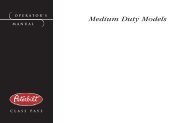MODEL 330 OPERATOR'S MANUAL - Peterbilt Motors Company
MODEL 330 OPERATOR'S MANUAL - Peterbilt Motors Company
MODEL 330 OPERATOR'S MANUAL - Peterbilt Motors Company
You also want an ePaper? Increase the reach of your titles
YUMPU automatically turns print PDFs into web optimized ePapers that Google loves.
Preventive Maintenance<br />
Due to these factors, the three-point safety belt system<br />
installed in your vehicle requires thorough inspection every<br />
20,000 miles (32,000 km). If the vehicle is exposed to severe<br />
environmental or working conditions, more frequent inspections<br />
may be necessary.<br />
Any seat belt system that shows cuts, fraying, extreme or<br />
unusual wear, significant discoloration due to UV (ultraviolet)<br />
exposure, abrasion to the seat belt webbing, or damage to<br />
the buckle, latch plate, retractor hardware or any other obvious<br />
problem should be replaced immediately, regardless of<br />
mileage.<br />
WARNING! It is important to remember that any<br />
time a vehicle is involved in an accident, the<br />
entire seat belt system must be replaced. Unexposed<br />
damage caused by the stress of an accident<br />
could prevent the system from functioning<br />
properly the next time it is needed, which could<br />
result in severe injury or even death.<br />
Inspection Guidelines<br />
Follow these guidelines when inspecting for “cuts, fraying,<br />
extreme or unusual wear of the webbing, and damage to the<br />
buckle, retractor, hardware, or other factors.” Damage to<br />
Cab Maintenance<br />
these areas indicates that belt system replacement is necessary.<br />
WARNING! Replace the entire belt system<br />
(retractor and buckle side) if replacement of any<br />
one part is necessary. Unexposed damage to<br />
one or more components could prevent the system<br />
from functioning properly the next time it is<br />
needed, which could result in severe injury or<br />
even death.<br />
1. Check the web wear in the system. The webbing must be<br />
closely examined to determine if it is coming into contact<br />
with any sharp or rough surfaces on the seat or other<br />
parts of the cab interior. These areas are typical places<br />
where the web will experience cutting or abrasion. Cuts,<br />
fraying, or excessive wear would indicate the need for<br />
replacement of the seat belt system.<br />
2. The pillar web guide (D-loop) is the area where almost<br />
constant movement of the seat belt webbing occurs<br />
because of relative movement between the seat and<br />
cab.<br />
3. Check the Komfort-Lok Latch for cracks or possible damage<br />
and check for proper operation.<br />
Model <strong>330</strong> PB1318 3/01 – 199 –
















